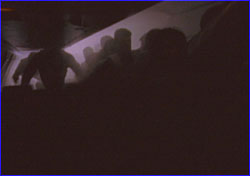
|
 |
 |
 Human Response
Human ResponseFire | Car | Plane | Ship Head Trauma One of the first things to be wary of after a crash of any kind is head trauma. Although the skull does a good job of protecting the brain—only about ten percent of all head injuries require hospitalization—a plane crash is very likely to cause more serious head injury. The most common potential complications are concussion, intracranial hematoma (blood clot between brain and skull), and skull fracture. Victims of such serious head trauma should be kept prostrate with head and shoulders slightly elevated. Stop bleeding with any cloth handy, and watch the person's vital signs. If breathing stops, CPR—an invaluable skill for dealing with all sorts of accidents—is essential. Shock Shock, which may result from injury, infection, burns, and other accidents, is caused by a reduction of blood flow. This produces a decrease in blood pressure and an inadequate supply of oxygen to body tissue. A victim's skin may appear pale or cool; his heartbeat may be weak and rapid, accompanied by shallow, hurried breathing; his eyes may be lusterless, with dilated pupils; and he may be faint, confused, or weak, if conscious at all. You should immediately lay a shock victim down, face upward, with the head below the level of the feet. Keep movement to a minimum, and keep the person warm and comfortable, but do not give him anything to drink, even if he complains of thirst. Otherwise, treat his other injuries as well as possible until help arrives. Broken Bones Fractures are perhaps the most common emergencies following crashes. The proper approach to fractures, while waiting for emergency medical assistance, is to protect the injury from further damage. Do not try to set a broken bone; you will likely do more harm than good. The most crucial thing is to immobilize the injured area. Use a splint to immobilize the joints above and below the fracture. If the fracture has caused bleeding, apply pressure to stop the bleeding, and if possible elevate the area above the level of the heart. Also look for signs of shock, and treat accordingly. Frostbite After a plane crash, you may find yourself stranded in freezing conditions. Such exposure, if prolonged, may cause the skin and underlying tissues to freeze. The skin grows hard, pale, and cold, and the area becomes insensitive to touch, although there is probably a sharp, aching pain. This is frostbite. First, warm the area by any way possible: If it's your hands, tuck them under your armpits; if it's your nose, ears, or face, cover the area with dry, gloved hands. Do not rub the affected area, and if it's your feet, do not walk; allow them to dangle while you wait for help (or someone else goes for help). If you're able to heat water, use warm—not hot—water to warm the area. Do not use other heat sources such as heating pads, because they will probably be too hot and burn the area. Insect Bites If you're stranded in a warm climate, insect bites can be a major hazard while you wait for help. People who are allergic to bee, wasp, or ant bites (about one person in ten) will find this a serious hazard. For this reason, anyone flying a small plane should carry insect repellant as well as first-aid equipment for stings and bites. You should remove any stingers left in your skin with a tweezers. You can use baking-soda paste or ice to reduce pain, and a hydrocortisone cream or calamine lotion can be effective in reducing itching and inflammation. An antihistamine, such as Benadryl, is also very effective for insect bites. Escape Through Time | Skydive | Human Response Survivor Stories | Pioneers of Survival | Survival Strategies Resources | Teacher's Guide | Transcripts | Site Map | Escape! Home Editor's Picks | Previous Sites | Join Us/E-mail | TV/Web Schedule About NOVA | Teachers | Site Map | Shop | Jobs | Search | To print PBS Online | NOVA Online | WGBH © | Updated November 2000 |